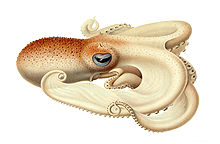| Velodona | |
|---|---|

| |
| Scientific classification | |
| Domain: | Eukaryota |
| Kingdom: | Animalia |
| Phylum: | Mollusca |
| Class: | Cephalopoda |
| Order: | Octopoda |
| Family: | Megaleledonidae |
| Genus: | Velodona Chun, 1915 |
| Species: | V. togata
|
| Binomial name | |
| Velodona togata Chun, 1915
| |
| Subspecies | |
| |
Velodona togata is a species of octopus in the monotypic genus Velodona. First described by Carl Chun in 1915, with a second subspecies discovered by Guy Coburn Robson in 1924, it was named for the distinctive membranes on its arms.
Described as being similar to members of the genera Pareledone, Eledone, and Enteroctopus, V. togata has a large body with large eyes and extensive membranes that link the octopus' arms together. The species has a single line of suckers on each arm, and its head, mantle, and part of its arms are covered in warts. Although the reproductive habits of V. togata have not been extensively studied, the species is believed to be one of the most fecund among octopuses in its region and depth level, despite the species possessing large eggs and extremely large spermatophores.
The species is found in the Indian Ocean, off the coast of South Africa, Mozambique, and Tanzania. The species has been captured from depths between 400 and 750 meters below sea level, and a 2009 study found the species most heavily concentrated between 400 and 600 meters below sea level. V. togata's conservation status has not been assessed.
- ^ Allcock, L.; Allen, G. (2018). "Velodona togata". IUCN Red List of Threatened Species. 2018: e.T162715A948474. Retrieved 18 January 2020.
